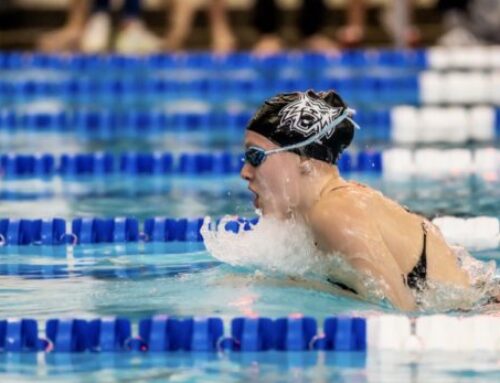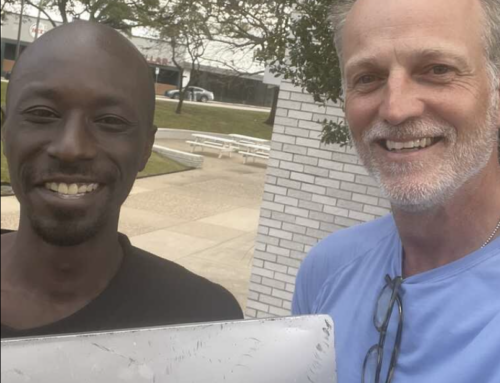Lying in bed every night, Patty Galvan hears the gunshots.
“I pray a lot of nights: Lord don’t let that be one of my friends. Don’t let that bullet fly through our house and hit either my mom, my brother or me.”
Patty Galvan is our neighbor, living just down the street.
She’s a 17-year-old senior at Woodrow Wilson High School, and she is growing up in a portion of our neighborhood most of us wish would go away.
This neighborhood is located about five minutes from most of our homes, but it has no proper name. It’s close to I-30, jammed between Downtown and Lakewood, just a few minutes from the stately homes on Lakewood Boulevard and the large mansions on Swiss.
It’s a neighborhood of poverty. Trash twirls in the street. Mangy dogs roam unchecked. Graffiti decorates buildings and fences. Homeless people sprawl on the streets.
Many homes don’t have running water and are roach- and rat-infested. Drugs, violence, gangs and prostitutes are the norm.
Little about this neighborhood offers hope – especially to the children who grow up there.
But Patty and many other residents are refusing to fall victim to their environment. They are fighting back with the help of educators and caring neighbors from the other side of the tracks.
This Thanksgiving, Patty and her neighbors are thankful for the few among us who simply refuse to let a portion of our neighborhood and its residents become statistics on the evening news.
The Difference A Name Makes
“Have you ever noticed the difference between Lakewood and East Dallas?” Jose Rodriguez asks. “If you’re driving down Abrams, once you hit Beacon, it changes.
“You see the liquor stores, the graffiti, the rundown apartments. You see the bums and gang members walking the streets looking for people to beat up.
“East Dallas is like a bad part of New York. It’s like the slums.”
“In East Dallas, two to three houses down from you is a drug dealer or a person stealing cars. In Lakewood, two to three houses down from you there’s a doctor or teacher.”
“I don’t call East Dallas mine. It’s just a product of people’s ignorance and their problems.”
Jose is a 19-year-old senior at Woodrow who moved to East Dallas about seven years ago from Chicago because his father heard there were opportunities in Texas.
“We moved down in a rusty, blue Chevy. We packed a picnic basket and put our clothes in Hefty bags and came down.”
Jose is the oldest of six children supported by their father’s $400-a-week income as a construction worker. The family lives in a two-bedroom apartment at Beacon and Henderson that costs $300 a month.
Jose’s parents share a bedroom with his two younger sisters, his brothers share the other bedroom, and Jose sleeps on the couch.
“It’s tough. Real tough. I don’t know how my dad does it,” Jose says. “He gets paid on Friday, and by Tuesday, he’s broke again.”
When his family moved to Dallas, Jose went to Roberts Elementary on East Grande at Munger, one block south of I-30. There, he met Jorge Perez, the man he credits with turning his life around. Perez was assigned by the I Have A Dream Foundation to mentor Jose’s class, which was considered at-risk because of where the students live – East Dallas.
Perez talked to the students about college and getting out of East Dallas. But in their neighborhood, Jose and his friends saw older guys making a living by stealing, dealing drugs and mugging people.
“It was too late to tell me to ‘just say no,’” Jose says today. “I had already seen all the money it can make you.”
“I’d say: ‘Look at those guys, they have watches, nice clothes and girls hanging all over them.’ Then there’s Jorge in khaki slacks and a white shirt and tie telling me I need to go to college. I’d think: ‘Why would I want to look like you when I can look like them?’”
“After my sophomore year, I realized Jorge was right all along.”
His sophomore year, Jose’s father was injured and couldn’t work. Jose dropped out of school and worked 60 hours a week to support his family.
“At night, I worked at a grocery store. During the day, I worked construction.”
“If I had stayed working, I wouldn’t have been able to help my family like I wanted. I was making good money, but it wasn’t enough. My family always needed stuff.”
Jose’s younger brother started dealing drugs to bring in money. He was arrested last year in front of a liquor store and convicted of drug-dealing. He’s facing three or four years in prison.
Jose’s brother is 17 years old.
“The worst moment in my life was seeing my brother going to jail. I could have helped prevent that. And seeing my dad’s disappointment. He wanted to being a man into this world. Instead he raised a drug-dealer who went to jail.”
Stepping Forward
Jorge Perez was assigned to mentor a class of 120 children at Oran Roberts seven years ago as part of the I Have A Dream Foundation. He lost track of some students, but he maintained ties with a core group that he helped through high school and some even into college.
Perez no longer works for the Foundation, so most of his work with neighborhood teenagers is on a volunteer basis.
Perez grew up in a single-parent family, and for most of his childhood, the family traveled the country as migrant workers. But Perez’s mother and a Sunday school teacher would not let him give up.
The challenged him to go for more. And he did.
Perez earned bachelor’s and master’s degrees. Today, he juggles a part-time job as the East Dallas YMCA’s youth program coordinator and a full-time position at Rainbow Days, where he trains adults to work with children.
He does for the neighborhood teenagers what his mother and Sunday school teacher did for him.
“Working with kids is like making a financial investment – the greater the risk, the more exceptional the return,” Perez says.
“These are kids walking on a tight rope without a net. Some of these kids know if they make a mistake, that’s it.”
He takes the teenagers on camping trips and to museums, and they talk about college. Perez even helps them apply for scholarships.
Last year, Perez helped 12 students attend college who probably otherwise wouldn’t have gone. This year, he is working with 10 students and is trying to attract more.
“People for too long have said: ‘Why don’t they do something about this problem?’, instead of, ‘What can I do?’”
“They’re fighting what seems to be a losing battle. But when the odds are the greatest, that’s when they shine the brightest.”
‘Lord Knows What They Can Do To Me”
“I always knew I wanted to get out of East Dallas,” Patty Galvan says.
“The people who lived around me – I was like, Lord only knows what they can do to me.”
As a small child, Patty lived with her parents and older brother in one bedroom of a three-bedroom house on Ash at Henderson. Her grandmother and aunts lived in the other two bedrooms.
When her grandmother died, her aunts moved out. Then her father remarried when she was 5, leaving the house to Patty, her mother and older brother, Victor. Her mother supported Patty and Victor as an assembly-line worker at Texas Instruments.
As children, Patty and Victor walked to Oran Roberts daily, traversing the narrow, unevenly paved streets of their neighborhood and beneath the underpass of I-30 to reach the school.
“The community I lived in, it was hard. You have to always watch your back. Every day, we walked to school together and held each other’s hand because we didn’t want anything to happen to each other.
“My mom would call the school every day to make sure we were there. My brother wasn’t always there, but I was. He would walk me to school, then leave.”
“Sometimes, he would come get me after school. Sometimes, I would walk home alone. I would always try to walk with a group of kids and have them surround me so I would be safe.”
“I was always anxious to go to school. For me, it was a way to get out of here. It was safe for me.”
“There was a girl I always wanted to be like. She was beautiful. Now, she has five kids, doesn’t have a husband and is living with her mom. I’m glad I’m not like her. She’s 17, too.
“It makes me sad to look around and see all this going on.”
Prior to fifth grade, Patty’s mom transferred Victor and her to Mt. Auburn Elementary at 6012 E. Grand.
“Two of my friends at Mt. Auburn dropped out in the sixth grade. They were pregnant. What kind of a life are they going to have?”
“Right now, I don’t want kids in my life. I saw what my mom went through. She struggled. I don’t want to struggle.”
“If I’m accepted to college, I’ll be the first one in my family to go to a university. I’m a senior, I’m not pregnant, and in seven more months, I’ll be out and in college.”
Showing Them Another Way
About a year ago, Leander Benavides of the Dallas Can! Academy took a HispanicWoodrow student out to eat with his family.
When they entered the restaurant, the student turned to Benavides and said: “I never knew Mexicans could go to places like this.”
“I had flashbacks to my childhood,” Benavides says. “If somebody like Dallas Can! had been around when I was a kid, I would have never dropped out.”
Benavides is the program coordinator for the Academy’s Accelerator Program at Woodrow. The Accelerator works with at-risk students who have low grades or have failed the TAAS test.
Freshmen and sophomores attend the course in the morning, and juniors and seniors attend in the afternoon. They receive personal counseling and concentrated academic attention to catch them up with their classmates.
The program is working.
Students who previously failed classes and skipped school are making the honor roll and attending school more than 90 percent of the time.
The point of the program is to help students before it’s too late, Benavides says.
Every Monday morning, Accelerator students shove their chairs in a circle. Then, Benavides clicks on a tape player, and a rap song starts playing. The kids stand up, some clapping and singing and others staring blankly at their classmates.
When the song is over, awards are distributed. Students receive recognition for attendance, grades, attitude or for making a tough decision.
One student slumps in his chair. He is dressed in baggy, black slacks and an oversized black shirt with a white T-shirt underneath, black Converse tennis shoes and a blue bandanna covers his head.
Throughout the awards ceremony, he sits seemingly disinterested. Then, it’s his turn.
When he stands to receive his Hang Tough award from Benavides, he grins broadly and grabs Benavides in a bear-hug. The award is two dogtags on a silver chain, one with a telephone number for Dallas Can!, Benavides says.
“He hasn’t missed a day of school,” Benavides says. “You’re talking about a tough ex-gang member. Did you see the way he hugged me? He pulled me in.
“They are street smart. They have been in the gangs, and they know the only way out is through education.”
“For some of the kids, there’s no place to study at home. They don’t finish high school because no one in their family finished school.”
“When it comes down to getting their own personal education or supporting their family, what do you think they’re going to do? They’re going to support their family.”
“They were taught they were second-class citizens. Now, they have respect for themselves.”
Making It
Noe Del Campo knew he wanted to go to college his junior year at Woodrow, but he didn’t know how to get there.
“I had never heard of the SAT. I never had a relationship with my counselor.”
“I didn’t think it was possible. Where am I going to get $5,000 a year? Where do I get scholarships? Where do I type essays for the applications?”
“I never knew a single person who went to college. No one ever talked about college. Everyone just worked.”
“I had a Hispanic coach at Woodrow who would say: ‘You’ve got to have ganas’ – the willingness to do something.”
“I’m not a genius, but I do have that willingness – that fight. If I hadn’t gone to college, I would have felt like a failure.”
He went to Jorge Perez, who helped prepare his college application. Today, Noe is a sophomore at the University of Texas at Arlington.
“Anybody can do it. You just have to have the door open for you. Jorge opened the door for me.”
Noe is the seventh of eight children. He grew up in East Dallas and was the first one in his family to graduate from high school. His father supported the family with $18,000 a year earned doing yard work in Highland Park.
“I saw how my dad works. How hard he works. I hate mowing yards. That’s what I was doing. That’s not going to get me anywhere.”
Noe visits home about once a month. His brothers and sisters and parents scrounge money together to help him at school. One brother gives him rides to and from school – it’s all the brother can offer.
“There are always problems at home – the light bill is not paid, the phone is off, the car broke down, the plumbing is out. People shouldn’t have to live this way. I don’t want them to live this way.”
“I see these Hispanic doctors, judges and constables and think I want to be one of them – one of the ones who make it.”
‘I Want To Get Out Of Here’
Jose Rodriguez invited a friend from Lakewood to his family’s apartment last year while they were working on a school project.
“He said: ‘Man this place sucks.’”
“If people pass through, it’s: ‘I don’t want to look. This isn’t happening three minutes from my home.’”
“They don’t see all the locks on our doors.”
“There’s rats, roaches, holes in the walls and rundown houses. People live there because they can afford it or they can’t get in the projects. Every weekend at my apartments, someone is getting evicted.”
“For most people it’s one, two, three, and you’re there. We’ve got to do 60 million extra steps just to get to two.”
“Everyone says: Opportunities are there for you, too. Apply for a scholarship.”
“How am I going to apply for a scholarship? I have one parent who doesn’t speak any English and another parent who can hardly read.”
Touring Jose’s neighborhood is like touring death. During the drive, he points out gang members and drug houses and spots where people have been killed and women have been raped and bars where customers are routinely picked off in the parking lot.
On East Side behind Cost Plus grocery store, the air reeks with the pungent smell of overly fermented booze. The sidewalk is paved with shattered beer bottles.
“All the kids hear about is: ‘This guy shot that person. This guy stole a car and didn’t get caught.’ They’re like heroes.”
“It’s all they know. It’s all they hear about.”
He sees a blonde woman sitting on a street corner with a grocery basket and a piece of cardboard with “Bible Covers For Sale” written in black marker.
“That’s why I want to go to college. That’s why I want to get out of here. I see that every day.”
“I want to work in law enforcement. The things that I know about people who deal drugs, nobody can take that away. I know how they think. I’ve been there.”
“A lot of my old friends are fathers, in jail or dead. I could have been like that.”
‘That’s The Only Way You Get Out’
Eduardo Torres is principal of Woodrow. He grew up like many of the students he educates.
“We had teachers who told us: ‘You have to read because that’s the only way you get out. You’ve got to do better than the previous generation.’”
“I want to do the same thing here.”
He posts signs in Woodrow’s hallways about reading and getting an education. He and the assistant principals provide free tutoring every Saturday.
Teachers are encouraged to implement more writing in their curriculums. Torres questions students about their homework and holds parent/student conferences.
“These kids are in an environment that is not conducive for enjoying life. For a 15-year-old kid to work til midnight, go home, then study and then have to be at school at 8 a.m. – then we look and wonder why these kids don’t get involved in extracurricular activities and go to football games.
“Their lives are so structured, they don’t have time for fun. They work to eat.”
“I make announcements in Spanish because some kids still don’t understand English. And I get sneers as I walk down the hallways. I’m not anti-American, I’m about communication.”
“I want them to say Woodrow taught me to be a person.”
Torres says about 65 percent of Woodrow’s student population is Hispanic, and almost that entire population lives in the low-income neighborhoods of East Dallas.
“A lot of these kids don’t have positive role models. They don’t have any hope. These kids are frustrated.”
“When you see your mom clean houses every day, and your dad works in a garage – when you grow up with that, you’re not exposed to the word ‘choreographer,’ you don’t know what a camera man does. We all make decisions based on our experiences.”
“If we expect them to be productive, respectful and educated, they will be. But it’s one thing to expect and another to work with them – rolling up your sleeves. That’s what we’re doing now.”
“People haven’t been in the schools, and they don’t know what’s going on. So they just give up.”
“I see miracles everyday. Some of these kids, coming to school everyday is a miracle.”
‘One Person Can Make A Difference’
Patty Galvan gets up every day at 4:30 a.m. to feed her dogs, get ready for school and wake up her brother – who takes her to school at 7 a.m. for drill team practice.
Her sophomore year, Patty recalls trying out for the drill team.
“Then the question came: Where is $300 going to come from for the uniform?”
Her father gave her $120, and she gave her sponsor her lunch money, $5 a week, until the tab was cleared.
Many mornings, Patty says she has to walk to practice. Sometimes, she arrives late.
“They sit there and gripe me out. I would say: You don’t have to live where I live.”
“They drive by, but driving by is not the same as living here. I have white friends who bring me home. They say: ‘You live here? Lock the door when you get out.’”
Patty works over the summer and every afternoon at the East Dallas YMCA. She’s saving money for her cap and gown, invitations to her graduation and for college, where she plans to study social work.
She wants to come back and work in our neighborhood.
“I just set my goals on one thing and went after that. They say one person can make a difference. I hope I’m that one person in East Dallas.”





